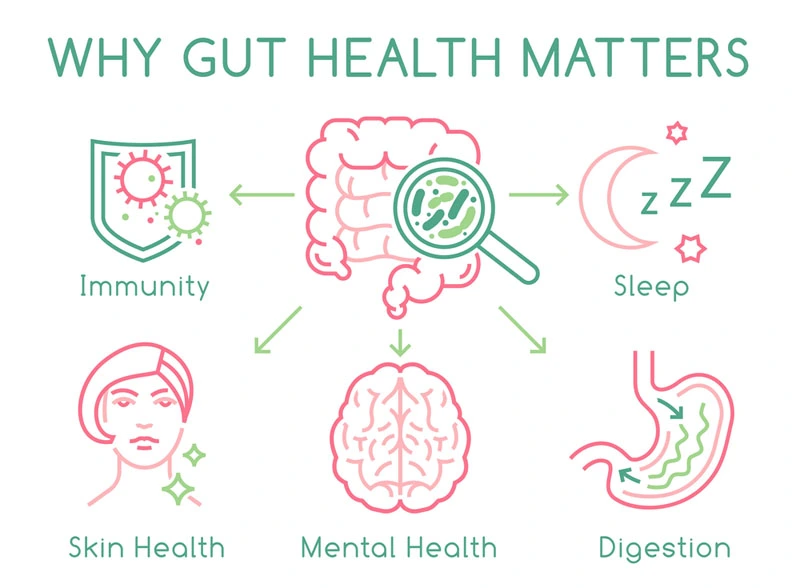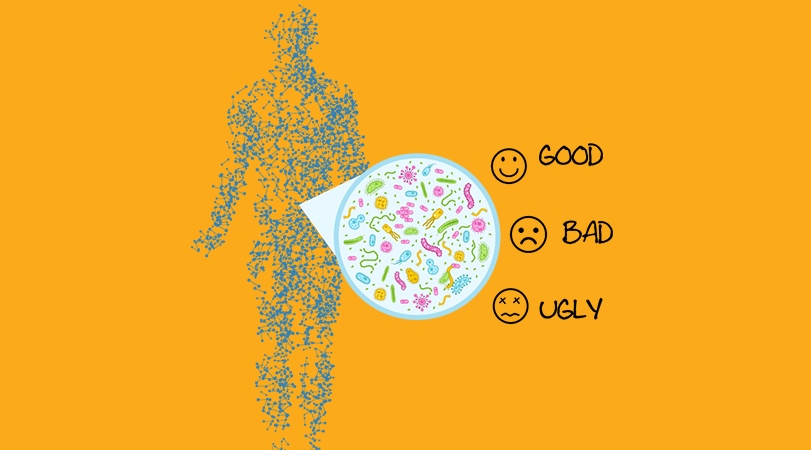The gut microflora and its genetic elements, collectively called the human gut microbiome, is a major organ that determines health and longevity. Of the trillions of commensal microflora in your gut, some perform key functions for your health, whereas others harm. Healthy weight management and body-mass-index (BMI), gut barrier function, immune maturation, and controlling inflammation are functions performed by beneficial commensal flora. From the information from recent microbiome studies, let us scan the good, bad, and ugly in the human gut microbiome.
| THE GOOD | THE BAD | THE UGLY |
| Akkermansia muciniphila Healthy weight management and controls of obesity and weight gain | Escherichia coli Overgrowth can ignite proinflammatory pathways | Helicobacter pyroli A pathogen is known to cause upper gastrointestinal tract diseases, such as peptic ulcer, gastric cancer, and gastric mucosa-associated lymphoid tissue (MALT) lymphoma. Recent studies have linked H. pylori infection to lower gastrointestinal tract diseases, such as colorectal cancer. It also increases the abundance of Candida glabrata and other unclassified Fungi. |
| Adlercreutzia equolifasciens Produces an important antioxidant from soy | Enterococcus spp Vehicle as antibiotic-resistant gene reservoir for gut microbiome | Clostridium difficile C. difficile is an infectious Gram-positive spore-forming bacillus microorganism of the gut microbiome, and its toxin expression causes a gastrointestinal illness with a wide spectrum of severity, ranging from mild diarrhea to pseudomembranous colitis, toxic megacolon, sepsis-like picture, and death |
| Oxalobacter formigenes Protects against the formation of kidney stones | Fusobacterium The presence of Fusobacterium nucleatum (F. nucleatum) in the gut is associated with the development of colorectal cancer. F. nucleatum promotes tumor development by inducing inflammation and host immune response in colorectal cancer. | |
| Christensenella minuta Supports lean body mass and obesity protection | Ruminococcus gnavus Increased proportion of Ruminococcus gnavus, populations produces glucorhamnan which induces flares of symptoms in patients with Crohn’s disease. | |
| Blautia luti & Blautia wexlerae Reduces visceral fat accumulation and Body-Mass-Index | Prevotella spp An abundance of Prevotella species at mucosal sites to localized and systemic disease, including periodontitis, bacterial vaginosis, rheumatoid arthritis, metabolic disorders, and low‐grade systemic inflammation | |
| Barnesiella Fights off antibiotic-resistant infections | ||
| Bifidobacterium & Lactobacillus Supports the production of secondary metabolites such as butyric acid, which is essential for immune activation. Bifidobacterium also prevents visceral fat accumulation. | ||
| Roseburia spp. It helps protect colonic mucosa against the development of inflammation and subsequent IBD. Roseburia is a dominant butyrate-producing Firmicutes. | ||
| Faecalibacterium prausnitzii A key marker of gut health due to its lower abundance in patients suffering from inflammatory bowel diseases compared to healthy controls and to its immunoregulatory properties | ||
| Ruminococcus bromii One of the most abundant bacteria constituting the human colonic microbiota and a primary degrader of resistant starch, an important non-digestible dietary polysaccharide. |
Top 6 good bacteria for your health
Good bacteria promote the gut’s overall health and enhance longevity. These are as follows:
- Akkermansia muciniphila
- Adlercreutzia equolifasciens
- Barnesiella
- Christensenella minuta
- Oxalobacter formigenes
- Roseburia spp
 Akkermansia Muciniphila:
Akkermansia Muciniphila:
A muciniphila is a key flora that strengthens the gut lining and, by doing so, protects against obesity and weight gain, as well as metabolic disturbances like insulin resistance.
The intestinal gut lining is an essential barrier that controls what can permeate into the systemic circulation, and it is lined with mucus, a protective coating, that strengthens it. The outer layer of mucus provides a home for several groups of bacteria, while the inner layer is compact and devoid of microbes.
Studies have shown that the inner mucus layer acts as a filter, preventing microbes from penetrating this barrier, which can cause unwanted inflammation. It also stops them from traveling in the bloodstream to places they shouldn’t, such as the lungs, where they can cause an infection. A. muciniphila feeds on the mucins (that compose the mucus layer), using them as an energy substrate. In turn, the gut lining cells respond by creating more mucus, controlling inflammation, and building up the thickness of this important layer of protection.
Adlercreutzia equolifasciens:
These bacteria turn compounds found in soy into a special antioxidant that may help prevent cancers and heart disease. Soybeans have been staples of the Asian diet for millennia, and because they’re cheap to produce, they made their way into processed foods. With the rise of vegetarian eating strategies, soy in its many forms (tofu, tempeh, natto, miso) has become a popular animal-friendly feature in the West.
This legume contains daidzein and genistein, two isoflavones of the phytoestrogen group that can help modulate immune system activity and prevent hormone-related cancers, post-menopausal symptoms, heart disease, osteoporosis, and even help preserve cognitive function.
A equolifasciens can quickly transform daidzein and genistein into equol, an isoflavone with stronger antioxidant and anti-inflammatory, and anti-tumor effects. Research indicates that equol may help prevent and reduce the risk of several gastric, breast, and prostate cancers. It may also play a role in preventing hyperglycemia linked to type-2 diabetes.
Barnesiella:
This species can prevent pathogenic antibiotic-resistant bacteria from colonizing the gut. Antibiotic resistance is a growing problem in modern-day medicine. Microbes evolve quickly in response to threats, creating new weapons to survive and thrive.
The widespread use of antibiotics has stimulated their evolutionary drive to avoid being killed. Hospitals and healthcare settings struggle to contain infections caused by antibiotic-resistant bacteria, especially since many patients have weakened immune systems due to illness and drugs.
In particular, common gut bacteria of the Enterococcus genus are no longer susceptible to vancomycin. This is a problem because they are apt to become overabundant in the gut of sick people, causing serious infections. Barnesiella, a genus of bacteria, can prevent vancomycin-resistant enterococci from colonizing the gut and has even been used to cure infections caused by them. It can even enhance the effectiveness of immunomodulatory therapy for certain types of cancer.
Christensenella minuta:
These hereditary microbes are more abundant in people of lean body mass, indicating benefits for weight management. Obesity is a serious health problem nowadays, affecting adults and many children. But carrying excess adipose tissue is far from an aesthetic debate. It disturbs the delicate balance of the body’s metabolism and makes people more susceptible to chronic, preventable diseases.
Obesity, type 2 diabetes, and heart disease are all linked to changes in human metabolism, the chemical reactions that keep us alive. Being overweight induces changes in metabolism that disrupt the activity of insulin, causing damage to the blood vessels due to high blood glucose, triglyceride, and cholesterol levels.
Christensenella is a heritable microbe passed down through families. Studies also indicate that these bacteria are enriched in the gut microbiome of people of lean body mass (BMI <25), compared to obese study participants, suggesting links between this newly discovered genus and healthy weight control.
Oxalobacter formigenes:
This species of bacteria can break compounds in plants that can cause calcium stones in the kidneys. Oxalates are naturally occurring plant compounds absorbed in the gut and usually removed from the body in your urine. They can bind with calcium during their journey to your toilet, and that’s usually not a problem. However, if a person’s diet contains too many oxalates, which are then absorbed by the colon and bind to calcium along the way, this can cause the most common type of kidney stones: calcium oxalate stones.
O. formigenes are interesting because they break down the oxalates from your food in the gut, reducing the amount of oxalate absorbed by the body. Studies analyzing levels of O. formigenes in stool are associated with the levels of calcium oxalate in urine.
The researchers further suggest that the presence of these bacteria in the microbiome can reduce a person’s risk of calcium oxalate kidney stones by up to 70%, and having none can significantly increase the levels of this compound that pass through the kidneys.
Roseburia spp.
It helps protect colonic mucosa against the development of inflammation and subsequent IBD. Recent studies indicated that R. intestinalis supernatant may regulate immune responses and ameliorate colitis.
Gut Microbiome and Precision Probiotics: A way to selectively enrich beneficial flora
Beneficial commensal bacteria thrive on prebiotic dietary fibers and polyphenols present in plant foods. While it’s not recommended, nor desirable, to attempt to pick and choose, promoting some microbes over others, just making simple changes to your diet can encourage the groups of beneficial bacteria to inhabit your microbiome. Precision probiotics are designed to enhance the functions of the human microbiome and comprise specific probiotic strains, prebiotic fibers, and polyphenolic compounds that work together to make secondary metabolites that are beneficial for body functions.
For example, citrus flavonoids have been shown to increase Blautia and Roseburia; human milk oligosaccharides (HMO) have also increased Bifidobacterium. Precision probiotics will be a main component in future personalized medicine for chronic diseases. A diverse gut microbiome with different commensal and beneficial bacteria can enhance your protection from common diseases, help you maintain a healthy weight, and even defend you against bad infections.
Frequently Asked Questions
Is ruminococcus bromii good or bad for gut health?
The bacterium Ruminococcus bromii is an essential component of a healthy gut, as it aids in breaking down dietary fiber, thereby promoting gut balance. Consuming a fiber-rich, balanced diet can foster the proliferation of this helpful microorganism.
Which foods increase the production of blautia?
The growth of Blautia in our gut can be stimulated by a diverse and fiber-dense diet encompassing fruits, vegetables, and whole grains. Foods that act as prebiotics, such as garlic, onion, and leeks, particularly support Blautia expansion.
What factors influence the composition of gut bacteria?
The composition of gut bacteria is influenced by multiple factors, including dietary habits, age, stress levels, the use of certain medicines, and the level of physical activity. Positive changes in your diet, regular exercise, and stress management can improve gut bacterial balance and health.
How does the gut microbiome affect digestion?
The gut microbiome is instrumental in our digestive process by decomposing food elements our bodies cannot process, synthesizing beneficial compounds, and regulating the immune system. Therefore, preserving a balanced gut microbiome is essential for efficient digestion and general well-being.
Citations:
- Luo W, Shen Z, Deng M, et al. Roseburia intestinalis supernatant ameliorates colitis induced in mice by regulating the immune response. Mol Med Rep. 2019;20(2):1007-1016. doi:10.3892/mmr.2019.10327
- Toh H, Oshima K, Suzuki T, Hattori M, Morita H. Complete Genome Sequence of the Equol-Producing Bacterium Adlercreutzia equolifaciens DSM 19450T. Genome Announc. 2013;1(5):e00742-13. Published 2013 Sep 19. doi:10.1128/genomeA.00742-13
- Ozato N, Saito S, Yamaguchi T, et al. Blautia genus associated with visceral fat accumulation in adults 20-76. NPJ Biofilms Microbiomes. 2019;5:28. Published 2019 Oct 4. doi:10.1038/s41522-019-0101-x




